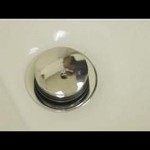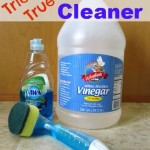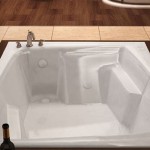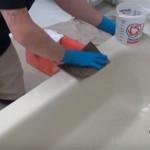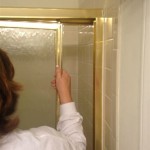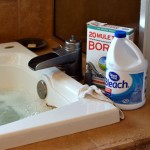Bathtub Sink Not Working
A non-functional bathtub faucet can disrupt daily routines and cause inconvenience. Understanding the potential causes and solutions can help homeowners troubleshoot the issue and potentially avoid costly plumbing repairs. This article explores common reasons why a bathtub sink might stop working and provides step-by-step guidance for diagnosing and resolving the problem.
One of the initial steps in troubleshooting a malfunctioning bathtub faucet is identifying the specific issue. Is there no water flow at all, low water pressure, or only hot or cold water running? Pinpointing the symptom helps narrow down the potential causes and direct the troubleshooting process more effectively.
Before delving into complex repairs, it's crucial to check the water supply. Ensure the main water valve to the house is fully open. Sometimes, the valve may be partially closed, restricting water flow to the entire house, including the bathtub. Additionally, check the individual shut-off valves located under the sink or near the water heater. These valves control the water supply to specific fixtures and may have been inadvertently closed.
A common culprit behind a non-functional bathtub faucet is a clogged aerator. The aerator is a small mesh screen at the end of the spout, designed to mix air with the water stream and conserve water. Mineral deposits and debris can accumulate in the aerator, restricting water flow. To check the aerator, unscrew it from the spout and inspect it for blockage. Cleaning or replacing the aerator is often a simple and effective solution.
Another potential cause of faucet malfunction is a faulty cartridge. The cartridge is a valve located inside the faucet handle that controls the flow and temperature of the water. Over time, cartridges can wear out or become clogged with debris. Depending on the faucet type, replacing a cartridge may require specialized tools. If troubleshooting other components doesn't resolve the issue, a faulty cartridge might be the underlying cause.
In some cases, a malfunctioning diverter valve can lead to water flow issues in the bathtub faucet. The diverter valve redirects water from the bathtub spout to the showerhead. If the diverter is stuck or broken, it may prevent water from flowing to the faucet. Inspecting and potentially replacing the diverter valve might be necessary if other troubleshooting steps are unsuccessful.
Low water pressure in the bathtub faucet can be indicative of several underlying problems. A buildup of sediment or mineral deposits within the pipes can restrict water flow. This issue may affect other fixtures in the house as well. Another possibility is a leak somewhere in the plumbing system. Leaks can significantly reduce water pressure, and timely detection and repair are essential to prevent further damage.
If the bathtub faucet only produces hot or cold water, the issue might lie with the faucet's mixing valve. The mixing valve blends hot and cold water to achieve the desired temperature. A malfunctioning mixing valve could restrict the flow of either hot or cold water. Repairing or replacing the mixing valve often requires professional assistance.
Troubleshooting plumbing issues can be complex, and sometimes professional help is necessary. If the problem persists after attempting basic troubleshooting steps, it's recommended to contact a qualified plumber. A plumber has the expertise and tools to diagnose and resolve more complicated plumbing problems effectively and safely.
Regular maintenance can help prevent future bathtub faucet problems. Periodically cleaning the aerator and checking for leaks can prevent clogs and water damage. Additionally, avoiding the use of harsh chemicals and abrasive cleaners can protect the faucet finish and prevent premature wear and tear.
When undertaking any plumbing repairs, it's essential to take necessary safety precautions. Turn off the water supply to the bathtub before disassembling any components. Wear protective gloves and eye protection when working with plumbing parts. If unsure about any step of the process, consult a professional plumber to avoid potential injury or damage.
Understanding the various components of a bathtub faucet and their function can assist in troubleshooting and resolving common issues. Familiarizing oneself with the location of shut-off valves and the process for checking and cleaning the aerator can empower homeowners to address simple problems independently. However, for more complex issues involving cartridges, diverter valves, or mixing valves, seeking professional assistance is often the best course of action.
Addressing bathtub faucet issues promptly can prevent further damage and restore functionality. By following a systematic troubleshooting approach, homeowners can identify the root cause of the problem and determine the appropriate course of action, whether it involves a simple fix or requires the expertise of a qualified plumber.

Bathroom Repair How To A Pop Up Tub Drain Stopper

Bathroom Repair How To A Pop Up Tub Drain Stopper

Bathtub Drain Clogged And No Around To Help

How To Fix A Bathtub That Won T Drain Forbes Home

How To Unclog A Bathtub Drain Homeserve Usa

How To Fix A Leaking Bathtub Faucet Diy Family Handyman

How To Unclog A Bathtub Drain 11 Diy Clog Busters

How To Adjust Bath Tub Drain Trip Lever

Water Coming Up Through Bathtub Drain Here S Why

Quick Tips To Unclog A Bathtub Drain Without Chemicals Plumbing Authority Inc

